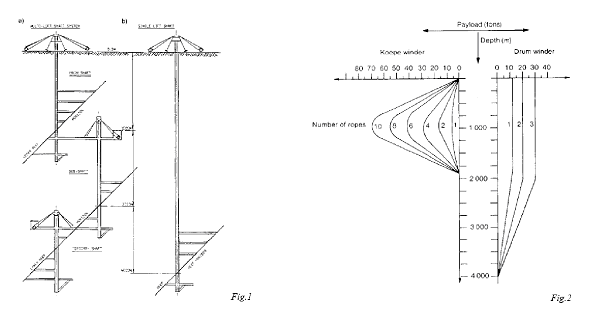
The mineral deposits are exploited on deeper and deeper levels. In connection with this, definitions like “deep level” and “deep shaft” became more and more popular. These definitions concern the depth where special rules regarding an excavation driving, exploitation, rock pressure control, lining construction, ventilation, underground and vertical transport, work organization and economics apply.
It has pointed out that the “deep level” is a very relative definition and should be used only with a reference to particular hydro-geological, mining and technical conditions in a mine or coal-field. It should be also strictly defined what area of “deep level” or “deep shaft” definitions are considered. It can be for example:
- mining geo-engineering,
- technology of excavation driving,
- ventilation (temperature).
It is obvious that the “deep level” defined from one point of view, not necessarily means a “deep level” in another area. According to [5] as a deep mine we can treat each mine if:
- the depth is higher than 2300 m or
- mineral deposit temperature is higher than 38 .C.
It is well known that the most of deep mines are in South Africa. Usually, they are gold or diamonds mines.
Economic deposits of gold-bearing ore are known to exist at depths up to 5000 m in a number of South Africa regions. However, due to the depth and structure of the reef in some areas, previous methods of reaching deeper reefs using sub-vertical shaft systems would not be economically viable. Thus, the local mining industry is actively investigating new techniques for a single-lift shaft up to 3500 m deep in the near future and probably around 5000 m afterwards. When compared with the maximum length of wind currently in operation of 2500 m, it is apparent that some significant innovations will be required.
The most important matter in the deep mine is the vertical transport and the mine hoisting used in the shaft. From the literature [1-12] results that B.M.R. (Blair Multi-Rope) hoist is preferred to be used in deep mines in South Africa. From the economic point of view, the most important factors are:
- construction and parameters of winding ropes (safety factor, mainly),
- mine hoisting drums capacity,
- low empty mass of the skip (the skip factor ”S”).
This article of informative character presents shortly above-mentioned problems based on the literature data [1-12]. Especially, the paper written by M.E. Greenway is very interesting [3]. From two transport systems used in the deep shaft, sub-vertical and the single-lift shaft systems, the second one is currently preferred. (Fig.1.)
The friction hoist (up to 2100 m), single drum and the double drum (classic and Blair type double drum) hoist are used in deep shafts in South Africa.

Drum winders are most widely used in South Africa and probably in the world. Three types of winders fall into this category
- Single drum winders,
- Double drum winders,
- Blair multi-rope winders (BMR).
In 1957 Robert Blair introduced a system whereby the advantage of the drum winder could be extended to two or more ropes. The two-rope system developed incorporated a two-compartment drum with a rope per compartment and two ropes attached to a single conveyance. He also developed a rope tension-compensating pulley to be attached to the conveyance. The Department of Mines allowed the statutory factor of safety for hoisting minerals to be 4,275 instead of 4,5 provided the capacity factor in either rope did not fall below the statutory factor of 9. This necessitated the use of some form of compensation to ensure an equitable distribution of load between the two ropes. Because the pulley compensation is limited, Blair also developed a device to detect the miscalling on the drum, as this could cause the ropes to move at different speeds and so affect their load sharing capability. Fig.2 shows the depth payload characteristics of double drum, BMR and Koepe winders.
The B.M.R. hoist is used almost exclusively in South Africa, probably because they were invented there, particularly for the deep shaft use...